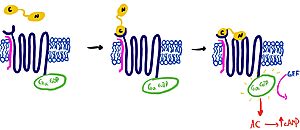Sandbox Ben Whiteside
From Proteopedia
(Difference between revisions)
| Line 1: | Line 1: | ||
==AMYR== | ==AMYR== | ||
| - | <StructureSection load='7tyf' size='340' side='right' caption='AMYR Bound to Amylin' scene='10/1038828/Entire_protein_scene/ | + | <StructureSection load='7tyf' size='340' side='right' caption='AMYR Bound to Amylin' scene='10/1038828/Entire_protein_scene/6'> |
==Introduction== | ==Introduction== | ||
When consuming food, the human body is tasked with secreting hormones and chemical messengers that will help regulate homeostasis. After a meal, the body has to maintain homeostasis by reducing blood glucose and signaling that enough nutrients have been consumed. During feeding, cells in the body will secrete the ligand, amylin. [https://en.wikipedia.org/wiki/Amylin Amylin] is a 37 amino acid glucoregulatory hormone that is produced within [https://en.wikipedia.org/wiki/Beta_cell beta cells] of the pancreas. When there is an influx of nutrients in the gastrointestinal tract, the ligand will bind to the heterodimeric receptor, activating the receptor and triggering the corresponding signaling cascade. The overall effect of this cascade is increased satiety, delayed gastric emptying, and inhibition of [https://en.wikipedia.org/wiki/Glucagon glucagon] secretion <ref name="Bower">PMID:27061187</ref>. The amylin receptors are widely distributed throughout the central nervous system <ref name="Hay">PMID:26071095</ref>. The amylin [https://en.wikipedia.org/wiki/G_protein-coupled_receptor g-protein coupled receptor] <scene name='10/1038828/Entire_protein_scene/4'>(AMYR) </scene>is a heterodimeric protein containing a [https://en.wikipedia.org/wiki/Calcitonin calcitonin] receptor domain, as well as one of three [https://en.wikipedia.org/wiki/Receptor_activity-modifying_protein receptor activity modifying proteins] (RAMP 1,2, or 3)<ref name="Cao">PMID:35324283</ref>. | When consuming food, the human body is tasked with secreting hormones and chemical messengers that will help regulate homeostasis. After a meal, the body has to maintain homeostasis by reducing blood glucose and signaling that enough nutrients have been consumed. During feeding, cells in the body will secrete the ligand, amylin. [https://en.wikipedia.org/wiki/Amylin Amylin] is a 37 amino acid glucoregulatory hormone that is produced within [https://en.wikipedia.org/wiki/Beta_cell beta cells] of the pancreas. When there is an influx of nutrients in the gastrointestinal tract, the ligand will bind to the heterodimeric receptor, activating the receptor and triggering the corresponding signaling cascade. The overall effect of this cascade is increased satiety, delayed gastric emptying, and inhibition of [https://en.wikipedia.org/wiki/Glucagon glucagon] secretion <ref name="Bower">PMID:27061187</ref>. The amylin receptors are widely distributed throughout the central nervous system <ref name="Hay">PMID:26071095</ref>. The amylin [https://en.wikipedia.org/wiki/G_protein-coupled_receptor g-protein coupled receptor] <scene name='10/1038828/Entire_protein_scene/4'>(AMYR) </scene>is a heterodimeric protein containing a [https://en.wikipedia.org/wiki/Calcitonin calcitonin] receptor domain, as well as one of three [https://en.wikipedia.org/wiki/Receptor_activity-modifying_protein receptor activity modifying proteins] (RAMP 1,2, or 3)<ref name="Cao">PMID:35324283</ref>. | ||
| Line 30: | Line 30: | ||
In order to restore basal amylin levels in mice, researchers have performed PEGylation, the addition of poly ethylene glycol, to amylin within residues 1-11 of the peptide, most likely at the two amine groups of K1<ref name="Guerreiro">PMID: 23818080</ref>. Administration of the modified amylin in mice showed evidence of reduced glycemia and prolonged action compared to endogenous amylin <ref name="Guerreiro"/>. | In order to restore basal amylin levels in mice, researchers have performed PEGylation, the addition of poly ethylene glycol, to amylin within residues 1-11 of the peptide, most likely at the two amine groups of K1<ref name="Guerreiro">PMID: 23818080</ref>. Administration of the modified amylin in mice showed evidence of reduced glycemia and prolonged action compared to endogenous amylin <ref name="Guerreiro"/>. | ||
| - | |||
| - | </StructureSection> | ||
== References == | == References == | ||
<references/> | <references/> | ||
| + | |||
| + | </StructureSection> | ||
| + | |||
== Student Contributors == | == Student Contributors == | ||
Andrew Helmerich, Mathias Vander Eide, Ben Whiteside | Andrew Helmerich, Mathias Vander Eide, Ben Whiteside | ||
Revision as of 14:22, 25 April 2024
AMYR
| |||||||||||
Student Contributors
Andrew Helmerich, Mathias Vander Eide, Ben Whiteside

